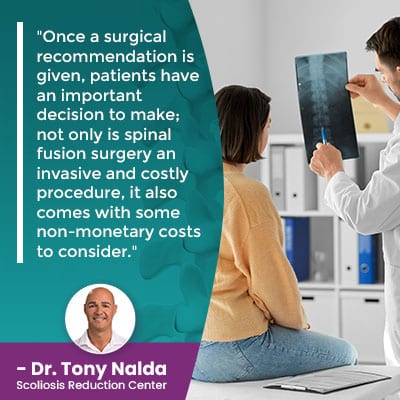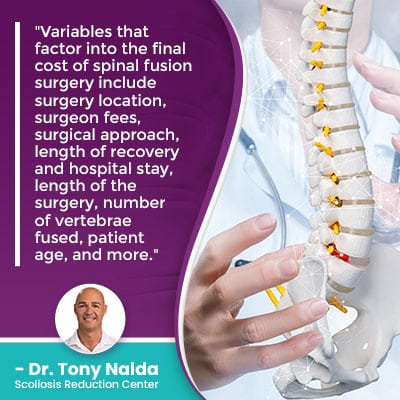How Much Is Scoliosis Surgery? Explore Scoliosis Surgery Costs

There are many variables that factor into determining the final cost of spinal fusion surgery such as condition severity, the number of vertebrae fused, location of the fusion site, whether or not there are complications, individual surgeon fees, etc.
Scoliosis surgery is a type of spinal fusion that is costly and invasive, but there are more than just monetary costs to consider. Many patients experience a significant loss of spinal flexibility and range of motion that can impact overall quality of life.
There are two main ways to approach scoliosis treatment, and it's important to understand the distinction because different forms of treatment offer different potential outcomes.
Table of Contents
What is Scoliosis?
Before getting to the specific cost, both monetary costs and other types of costs, associated with spinal fusion surgery, lets first define the condition itself.
If someone is diagnosed with scoliosis, this means they have developed an unnatural sideways spinal curve that also rotates.
It's the rotational component that sets scoliosis apart from a number of other spinal conditions that involve a loss of its healthy curves because a scoliotic curve doesn't just bend unnaturally, but also twists, making it a complex 3-dimensional condition.
Scoliosis is a structural condition, and part of diagnosing scoliosis involves comprehensively assessing conditions and further classifying them based on key patient/condition variables, and these variables also determine whether or not a surgical recommendation is given.
Scoliosis ranges widely in severity, and condition severity is one of the main factor that affects whether spinal fusion surgery is recommended or not.
Condition severity is determined by a measurement known as Cobb angle, and this is determined during X-ray by drawing lines from the tops and bottoms of the curve's most-tilted vertebrae, at its apex.
When the spine's healthy curves are in place, it can function as designed, as the natural spinal curves make it stronger, more flexible, and better able to distribute/absorb mechanical stress incurred during activity.
When the spine loses one or more of its healthy curves, its overall strength, function, and flexibility are disrupted, impacting the biomechanics of the entire spine.
Being diagnosed with scoliosis also means being diagnosed with a progressive condition.
Scoliosis is a Progressive Condition
The condition's severity levels are the same as its progressive line; scoliosis has it in its nature to worsen over time, particularly if left untreated, or not treated proactively.
Only proactive treatment can help counteract the condition's progressive nature and can work towards preventing further progression, increasing condition severity, and the need for invasive surgical treatment.
The higher a patient's Cobb angle, the more severe the condition, and the more noticeable its effects are likely to be:
- Mild scoliosis: Cobb angle measurement of between 10 and 25 degrees
- Moderate scoliosis: Cobb angle measurement of between 25 and 40 degrees
- Severe scoliosis: Cobb angle measurement of 40+ degrees
- Very-severe scoliosis: Cobb angle measurement of 80+ degrees
The reality is that many cases of scoliosis can be treated without surgery, and one of the key factors that determine whether or not a surgical procedure is necessary is how a patient's diagnosis is responded to.
Scoliosis Treatment Options
There are two main scoliosis treatment approaches for patients to choose between, and treating scoliosis has far-reaching effects, so both options should be considered carefully.
As a progressive condition, scoliosis is incurable, but it can be highly treatable.
Traditional scoliosis treatment plans tend to funnel patients towards spinal fusion surgery, while modern conservative scoliosis treatment integrates multiple types of treatment to impact conditions on every level.
For those on the path of traditional treatment, it's important to know that this approach doesn't have a strategy for treating scoliosis while mild, which is why it commonly recommends that mild scoliosis patients simply watch and wait, rather than responding proactively.
Mild scoliosis can easily progress to become moderate, severe, or very severe, and once a patient's scoliosis progresses into the severe classification at 40+ degrees, as little was done beforehand to prevent progression, these patients become surgical candidates.
 Once a surgical recommendation is given, patients have an important decision to make; not only is spinal fusion surgery an invasive and costly procedure, it also comes with some non-monetary costs to consider.
Once a surgical recommendation is given, patients have an important decision to make; not only is spinal fusion surgery an invasive and costly procedure, it also comes with some non-monetary costs to consider.
What is Spinal Fusion Surgery?
While there are different types of scoliosis surgery, most involve working towards stopping progression by fusing the curve's most-tilted vertebrae into one solid bone.
Between adjacent vertebrae (bones of the spine), there is an intervertebral disc, and between each pair of vertebrae being fused, an intervertebral disc will need to be removed and can involve a bone graft.
The spinal discs are key to the spine's optimal health, strength, structure, and flexibility, so removing one or more of the intervertebral discs is contrary to its natural design.
There are three main sections of the spine, and while it most commonly affects the thoracic spine, scoliosis can develop in any of its sections: cervical spine (neck), thoracic spine (middle/upper back), and the lumbar spine (lower back).
Fusing the vertebrae is done to prevent movement (progression) in the vertebrae, meaning they can't become more tilted, although there is always the risk that progression can still occur.
Once the vertebrae are fused into one solid bone, rods are commonly attached to the spine with pedicle screws to hold it in place, and hardware attached is permanent; if there is an adverse reaction, or a hardware malfunction in the future, the only recourse is more surgery.
So for those wondering about scoliosis surgery cost, let's discuss some variables that help determine the total costs of spinal fusion.
How Much is Scoliosis Surgery?
Just as no two cases of scoliosis are the same, no two patients are going to respond to spinal fusion in the same way.
Complications, or successful results, one patient experiences aren't a fair indication of what others will experience, which is why there is not one flat surgical rate for spinal fusion.
 Variables that factor into the final cost of spinal fusion surgery include surgery location, surgeon fees, surgical approach, length of recovery and hospital stay, length of the surgery, number of vertebrae fused, patient age, and more.
Variables that factor into the final cost of spinal fusion surgery include surgery location, surgeon fees, surgical approach, length of recovery and hospital stay, length of the surgery, number of vertebrae fused, patient age, and more.
In addition to the invasive nature of the procedure, scoliosis back surgery cost can be high, and while there are a number of factors (surgeon fees, surgery location, recovery time spent in hospital, surgery length, condition severity, patient age, etc.) that can make the cost fluctuate from anywhere between $26 653 and $129 220.
Of course, if there are any unexpected complications, or the need for subsequent surgery is needed, those average costs and estimates will only increase.
Conclusion
For patients recently diagnosed with scoliosis, the most important decision to be made is how to treat the condition moving forward, and this is because as a progressive condition, scoliosis is incurable, but it can be highly treatable.
How a diagnosis of scoliosis is responded to is key, although there are never treatment guarantees.
Those whose scoliosis is diagnosed early in its progressive line have better chances of treatment success, but only if a proactive conservative treatment approach is applied and started as close to the time of diagnosis as possible.
As scoliosis progresses, the unnatural spinal curve is increasing in size, as are the condition's uneven forces, and their effects.
As a scoliotic curve gets larger, the spine becomes more rigid, making it less responsive to treatment, and chiropractic care is the linchpin of conservative treatment.
When condition-specific chiropractic care is applied by scoliosis specialists, and combined with other forms of treatment such as physical therapy, corrective bracing, and rehabilitation, scoliosis can be impacted on every level so patients can avoid surgery.
While spinal fusion can help achieve a straighter alignment for the scoliotic spine, this treatment can cost the spine in terms of its overall health, strength, and function.
By fusing multiple vertebrae together, movement in that area of the spine is disrupted, and this is contrary to the spine's movement-based design; many patients are disappointed with the loss of spinal flexibility and range of motion they experience post-surgery.
In addition, there is also the psychological cost of knowing the spine is weaker and more vulnerable to injury that can also impact a patient's quality of life.
A spine that's held in place by artificial means is not the same as working towards corrective results through conservative treatment that strives to preserve as much of the spine's natural strength and function as possible.
Here at the Scoliosis Reduction Center, I value proactive treatment that helps patients avoid the hardships associated with increasing condition severity and invasive surgical treatment.
Dr. Tony Nalda
DOCTOR OF CHIROPRACTIC
After receiving an undergraduate degree in psychology and his Doctorate of Chiropractic from Life University, Dr. Nalda settled in Celebration, Florida and proceeded to build one of Central Florida’s most successful chiropractic clinics.
His experience with patients suffering from scoliosis, and the confusion and frustration they faced, led him to seek a specialty in scoliosis care. In 2006 he completed his Intensive Care Certification from CLEAR Institute, a leading scoliosis educational and certification center.
About Dr. Tony Nalda
 Ready to explore scoliosis treatment? Contact Us Now
Ready to explore scoliosis treatment? Contact Us Now





